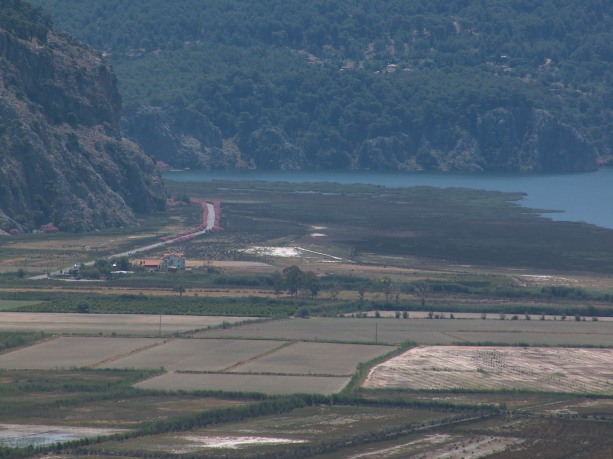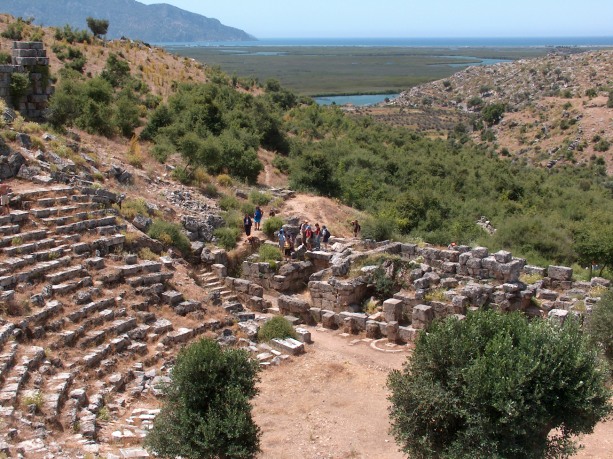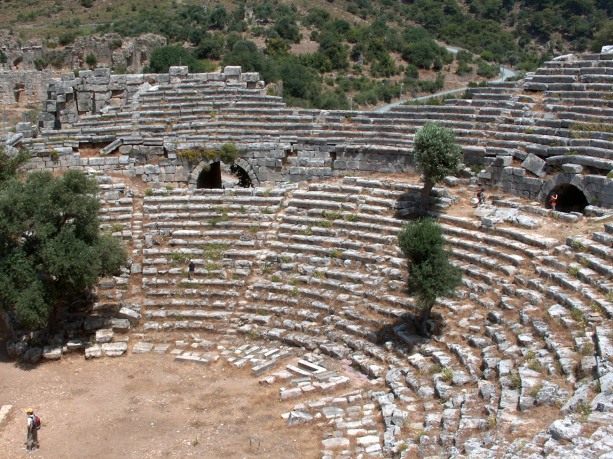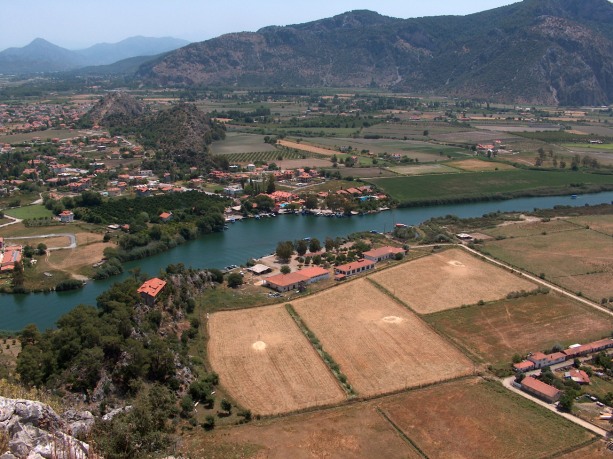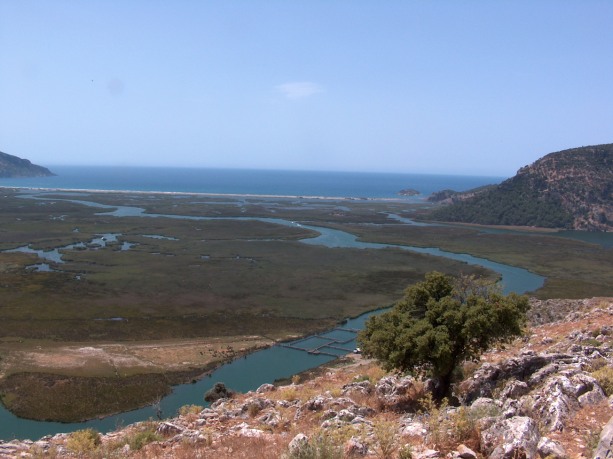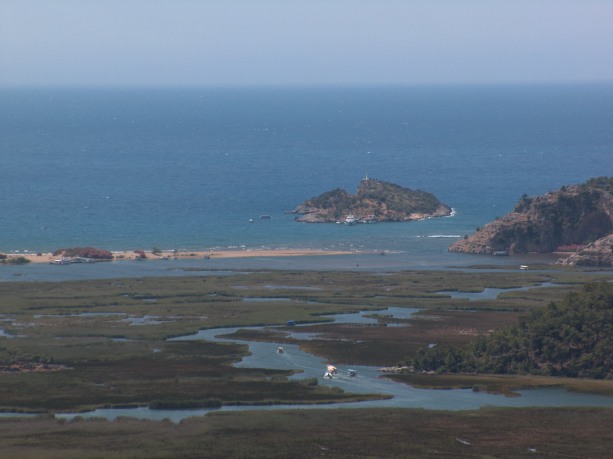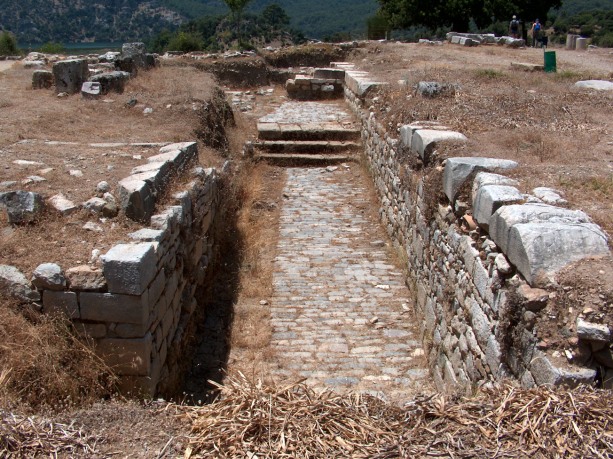DALYAN
The town of Dalyan has a history probably dates back to the 13th century , but which received on status strategically speaking during Süleyman the Magnificent's Rhodes campaign. More recently, about 30 to 40 years ago, this settlement turned village was almost exclusively dependent on agriculture and fishingfor its sustenance. Then in the 1980's Dalyan saw a quick rise in tourismas word got out that forgotten jewel was situated right in the middle of one of the world's most rare and bountiful ecosystems. To be in this splendid corner of nature which took thousands of year to develop while facing the ancient city of Caunos is indeed an unforgettable experience. Nature and history offer a bouquet of wonders in Dalyan. An earthly paradise…
After the 1980s the Dalyan developed like a pearl, turning itself into a world famous tourism center. Registered as a Nature Reserve in 1988, it was saved from uncontrolled housing development and population growth. Thankfully, the ecosystem consisting of the Köyçeğiz Lake, the Dalyan River, the Delta and Iztuzu Beach maintain a status of preserved abundance. In other words, it is a bouquet of wonders...
 Situated in the midst of a rare ecosystem, Dalyan is not a seaside town, but it has both one od the most beautiful beaches in the world nearby, a unique delta, as well as wonderful lakes that inspire exploring, such a Sulungur, Tuz Lake and Alagöl that are all situated on the Delta. The ancient city of Caunos, the history of which dates back to the 1st millenium BC, is just across the river. Ruins from a wandering wall that once defended the old city, rises and falls along the steep gradient that holds the terraced Acropolis. Monumental tombs belonging to noble families of Caunos are also found here, carved deeply into a steep cliff of limestone, modelled from temple facades. The bouquet of attractions invide lovers of nature, history and archaeology to return time and time again (Türe, Altan-2011).
Situated in the midst of a rare ecosystem, Dalyan is not a seaside town, but it has both one od the most beautiful beaches in the world nearby, a unique delta, as well as wonderful lakes that inspire exploring, such a Sulungur, Tuz Lake and Alagöl that are all situated on the Delta. The ancient city of Caunos, the history of which dates back to the 1st millenium BC, is just across the river. Ruins from a wandering wall that once defended the old city, rises and falls along the steep gradient that holds the terraced Acropolis. Monumental tombs belonging to noble families of Caunos are also found here, carved deeply into a steep cliff of limestone, modelled from temple facades. The bouquet of attractions invide lovers of nature, history and archaeology to return time and time again (Türe, Altan-2011).
KAUNOS
The most ancient find of the Caunos excavations is a piece of a protogeometric amphora dating back to the 9th century BC. In addition to this , the geometrical style designs of ceramic vessels patterned with concentric circles drawn between lateral bands or with semicircular motifs, were products of local pottery workshops and Herodotus comment that the people of Caunos were the natives of the land, bring to mind a settlement that dates far back. However, no architectural objects that can be dated to before the 4th century BC have been found in Caunos as yet. A statue of a young man that was excavated in front of the western gate of the city walls, pieces of Attic ceramic with black-figure patterns, which were expensive imported objects, as well as the archaic walls that surround the city in a south to south-easterly direction, woven with large boulders, some of which were roughly hewn to sit on each other , are archaeological proofs of the 6th century BC.
These find indicate that Caunos had been a rich and important seaport after 6th century BC. However, Caunos is not a mentioned in historical sources until the Persians destroy the kingdom of Lydia in 546 BC and annexed the whole of Anatolia. The earliest and most important information on Caunos is given by Herodotus, who relates that “ the people of Caunos put up a fierce resistance against the Persian general Harpagos, but were eventually defeated . “ In the year following Xerxes' defeat in his Greek campaign and the Persians ' having to retreat from the coast of Western Anatolia, Caunos, like many other seaports, took part in the Delian League, formed by the Athenians against the Persians. At the beganning Caunos paid the League only a nominal tax, as little as half a talent. However, in 425 BC this tax was suddenly raised to the same amount paid by Miletos, which was 10 talents ( silver coins equel to 3000 Republic gold coins). There is no proof that this high amount was actually paid, but what is interesting is that it indicates that the city suddenly bacame richer. The source for this sudden wealth may be because the people of Caunos opeded new farmland, or because the demand for the city's export, which were salt, salted fish, slaves, pine resin and the pitch that was obtained by burning this resin.
The fact that Thucydides, who recounts the Peloponnesian Wars between Athenians and Spartans resulting in Athens' defeat, mentions that “ the fleets of both sides used the port of Caunos” which indicates that Caunos pursued a flexible policy. The King's Peace of 387 BC placed Caunos back under Persian sovereignty like all other coastal cities of Anatolia. During the Hekotomnos dynasty that rule the Carian satrapy of the empire, especially during the reign of Mausolus, the city was enlarged with a new building plan involving terraces on the steep land and was enveloped with walls. The Asian campain that started when Alexander the Great, king of Macedonia, set foot on Anatolian soil in 334 BC resulted in the destruction of the Persian Empire and the rise of the Hellenistic Empire. However, there was continuous conflict between the emerging Hellenistic kingdoms shared by Alexsander's generals upon his death in 323. Being a strategic seaport, Caunos kept changing hands, resulting from invasions and political manoeuvres, and became a Rhodian dominion a couple of times.
The balance of power began to shift when Rome, rising as a new imperialistic force in world history, started annexing all Hellenistic kingdoms through war or politics. When Antiochus, King of Syria, was defeated in the war he waged with Rome in Magnesia in 189 BC, the Roman Senate left the administration of all of Caria and Lycia to Rhodes. Having had enough of Rhodian oppression, the western Anatolian cities rose in revolt in 167 BC. This revolt, in which Caunos also took part, was suppressed but Romans made Rhodes leave Anatolian soil.
In 129 BC, Rome founded the “ Province of Asia” that covered a large part of western Anatolia. Being one of the border cities of this province, Caunos was attached to Lycia after a revised administration plan. Under Roman rule, citizens of Rome, most of whom were traders and bureaucrats, started to live in Anatolian cities. Combating Roman expansion, Mithridates, King of Pontus, invaded the region in 88 BC. The people of Caunos supported the king and brutally killed all Romans in their city.
After making peace in 85 BC, Rome dealt Caunos a severe punishment and once more put them underthe rule of those despised Rhodians. Towards the ends of the 1st century BC, Caunos once more gained its independence. However, the fact that the Sophist Dio Chrysostomos mentioned that “ the people of Caunos had to suffer the double rule of Rome and Rhodes” and in his writing dating back to 70 AD, indicates that the Rhodians once again had a say in the city's affairs.
For the centuries that Rome thrived peacefully as an empire, Caunos was free of military and economic pressure and continued its existence as a rich seaport. In the early years of the Empire, the theatre underwent an enlargement almost at the scale of a full restructuring, at which time a large bath ( essential for a Roman city) and a wide palaestra were built on the terrace just in front of it. The Agora fountainwas also renewed and temples were built. The people of Caunos erected statues of the Roman emperors Tiberius, Nero and Vespasian as well as those of Romen ambassadors and senators around the agora and on the Apollo sanctuary in order to demonstrate their loyalty. They even honoured famous Romans who visit their city by erecting their statues.
The rock on which stands Caunos' small castle and cove to the north of the peninsula had already become a swamp that filled gradually and was abondoned by the 8th century. The inner port of the cove to the south of the island was still open to the sea, however. But when the front of southern port also bacame blocked with reeds and swampy water between 100 BC and 200 CE, the city was cut off and left far from the sea. When in the tumultuous time that the Roman Empire officially adopted Christianity as its religion, and any trace of paganism was destroyed, especially temples to god and goddesses, Caunos must have been considered a prominent centre, with its five churches standing proudly a top the hill. During this periods Caunos' name was christianised to become Caunos-Hegia, as it was zoned within the Episcopal Lycia provinceand subjected to the two Papal Sees. With all turmoil of Muslim-Arap raids and pirate attacks after 625 and then Turkish invasion at thr beginingof the 13th century, the ancient castle at the top of Acropolis was fortified with Byzantine walls. These walls, a greater part of which still stand, lent Caunos the appearance of a medieval city. Caunos was completely abandoned after Turkish tribes overran the whole of Caria in the 15th century (Öğün, Işık- 2001).
CARETTA CARETTA
Sea turtles have been living on earth for 110 million years, the human being, however, for only 2-3 million years. Of the eight species living in the world's seas, five are present in the Mediterranean. It is estimated that only a limited number of individuals the Leatherback Sea Turtle, the Hawksbill Sea Turtle and the Kemp's Ridley Sea Turtle species enter the Med for nutrition or by mistake. The other two species are the Caretta Caretta ( Loggerhead Sea Turtle) and the Chelonia Mydas ( Green Sea Turtle) . The nesting areas of almost half of these that live in the Med is, Turkey's Med coast . Like the other sea turtles, these two species spend their entire life in the sea and come to beaches only to dig a nest and lay their eggs.
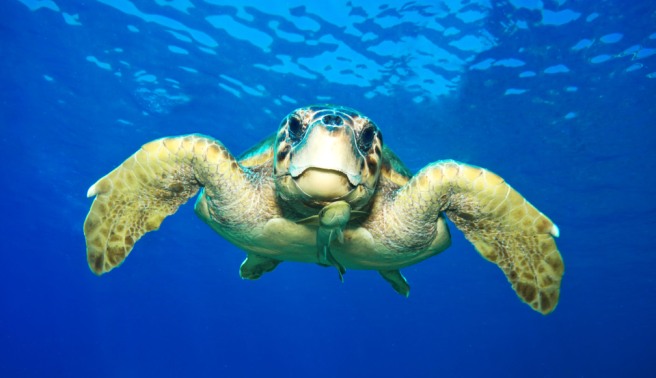
Research shows that the sea turtles living in the Med are species that are partly genetically modified. The meaning of this that, apart from accidental entries and exits, Med sea turtles do not go to the ocean after laying eggs. Turtle of other seas, do not enter the Med. However, Med sea turtles can migrate between their reproduction and wintering areas within this sea. The Greek, Turkish and Cyprus coasts are their most important nesting areas while the shores of Tunisia, Libya, Italy ans Spain are their most important wintering and feeding areas. More than half of the Med Caretta Caretta population come to Turkey's Western ans Central Med coasts, especially to Iztuzu, Belek, Kızılot and Anamur, to layeggs. It is known that yearly an avarage of 2000 Caretta Caretta nests are made in the Turkish coast and that an average of 100 eggs is laid in each nest. Considering that a mature female makes a nest 4 to 8 times each season, we know that annually about 500 Caretta Caretta females nest in the beaches of our country. Only a scant few , about 2 or 3 of the 1000 young that are able to hatch, live for 25 years and reach maturity.
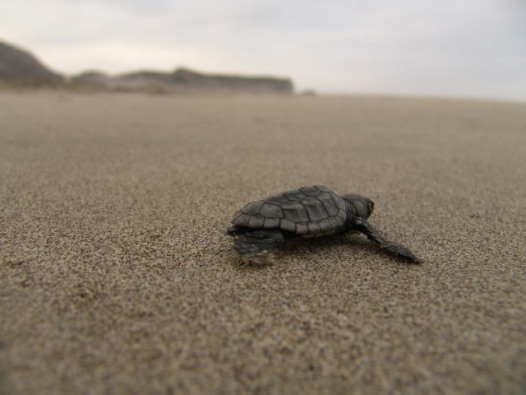
In the Caretta Carettas' life cycle, each maturing generation returned to the beach it was born for reproduction. They mated in the shollow water of the beach they recognise, thanks to a million-year genetic memory and buried their eggs into the nests they opened in the sand of the same beach. The Caretta Carettas reach sexual maturity at 25 and reproduce in March, April and May. Their eggs-laying season is the months of June, July and August. In order to lay the eggs fertilised with the sperms they store and keep alive, the females bury about 90-100 eggs into the holes they open in the beach at a frequency of 4 to 8 times a night at 12-13 day intervals.
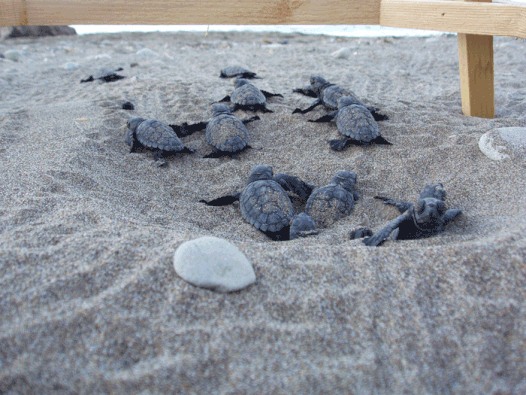
Incubation last two months, and if the temperature of the sand is above 37 centigrade during this periods, all of the young in the nest become females and cooler temperatures produce male offspring. The eggs hatch while the parching heat of the sun burns the sand, but the young , upon instinct, wait for the dark and cool hours of night to dig the sand and treat on each other to get out.
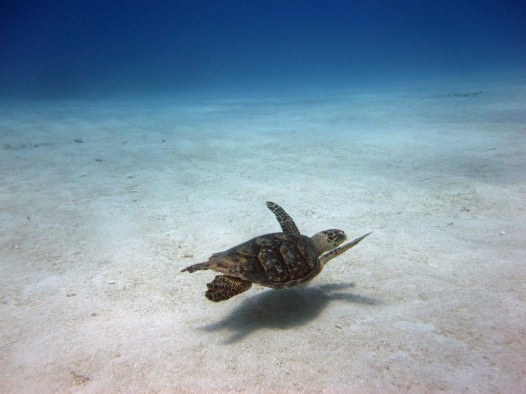
Then they run towards the pale glint of the sea with all their might and jump into the salty water. Nature has equipped them with two special devices in their competition on the thin line that seperates life and death. The Loggerheads with two features that help them in their race to defy death. The tusk-like projection on the heads of the young turtles enables them to crack the shell of the egg and then disappears in time. A pea-size accumulation of fat in their abdomen is the energy stock they require to reach the sea quickly.
This race to live and die is full of obstacles, most of which are man-made. If there are bright lights on the beach due to camps and facilities, the young go inland towards them instead of the sea. When they fall into the deep tracks of car wheels and holes they are mostly unable to get out and fall prey to seagulls, crabs and other carnivores when the sun rises or dehydrate and die. Reaching the sea does not guarantee life for these cute little turtles. They have to swim 24 hours non-stop to reach open sea in order to avoid the large predatory fish that wait for them in the coastal water.
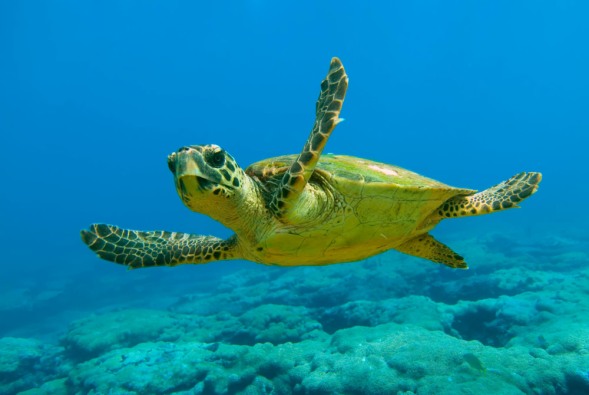
Another increasingly harmful activity is the "sea turtle watching tour", where turtles are illegaly fed at the delta side of the beach. As Lindos Pension, we strongly object to these tours and request that you do not attend, as the sea turtles tend to stay in the delta section due to these boat tours, get more injuries due to heavy river traffic, and get used to the unnatural way of feeding.
NO FEEDING, NO WATCHING TOUR!

